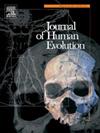Uniform, circular, and shallow enamel pitting in hominins: Prevalence, morphological associations, and potential taxonomic significance
IF 3.1
1区 地球科学
Q1 ANTHROPOLOGY
引用次数: 0
Abstract
This study explores a particular form of enamel pitting originally identified in Paranthropus robustus. We call this uniform, circular, and shallow (UCS) pitting to distinguish it from more irregular and nonuniform defects often associated with enamel hypoplasia. We pose the hypothesis that UCS pitting is unique to the genus Paranthropus. We test this by investigating hominin dental remains from the ca. 3.4 Ma to ca. 1.1 Ma fossiliferous sequence at Omo, Ethiopia (n = 76) to look for evidence of UCS pitting in an assemblage that includes at least three hominin genera (Australopithecus, Paranthropus, and Homo). We also examine the correlation between UCS pitting, tooth size, enamel thickness, and cusp proportions in samples from both eastern Africa (Omo) and southern Africa (Drimolen Main Quarry ∼2.04–1.95 Ma, Swartkrans ∼1.9–1.4 Ma, and Kromdraai ∼1.95–1.78 Ma). In the Omo specimens, we found UCS pitting similar to that seen in P. robustus. While we observed this pitting on five of 24 permanent teeth and two deciduous molars from both Paranthropus aethiopicus and Paranthropus boisei, we also identified UCS pitting on five of 13 non-Paranthropus hominin permanent posterior teeth from Member B (∼3.0 Ma). Our correlation studies yielded no association between the presence of UCS pitting and variation in tooth size, enamel thickness, or cusp proportions. The consistent appearance and characteristics of UCS pitting suggest a shared etiology. Our findings also suggest that UCS pitting may result from a genetic effect related to enamel formation, potentially in association with specific environmental or dietary factors.
古人类的均匀、圆形和浅牙釉质凹陷:流行、形态关联和潜在的分类意义
这项研究探索了一种特殊形式的牙釉质蚀,最初在傍人粗壮人中发现。我们称其为均匀、圆形和浅(UCS)点蚀,以区别于通常与釉质发育不全相关的不规则和不均匀的缺陷。我们提出的假设,UCS点蚀是独特的属Paranthropus。我们通过研究埃塞俄比亚Omo约3.4 Ma至1.1 Ma化石序列的古人类牙齿遗骸(n = 76)来验证这一点,以寻找包括至少三个古人类属(南方古猿,傍人猿和人属)的组合中UCS凹陷的证据。我们还研究了东部非洲(Omo)和南部非洲(Drimolen Main Quarry ~ 2.04-1.95 Ma, Swartkrans ~ 1.9-1.4 Ma和Kromdraai ~ 1.95-1.78 Ma)样品中UCS点蚀、牙齿大小、牙釉质厚度和牙尖比例之间的相关性。在Omo标本中,我们发现了类似于在P. robustus中看到的UCS点蚀。我们在埃塞俄比亚傍人猿和博瓦塞傍人猿的24颗恒牙中的5颗和2颗乳牙上观察到这种凹陷,同时我们也在成员B (~ 3.0 Ma)的13颗非傍人古人类永久后牙中的5颗上发现了UCS凹陷。我们的相关研究显示,UCS凹陷的存在与牙齿大小、牙釉质厚度或牙尖比例的变化没有关联。UCS点蚀的一致外观和特征提示有共同的病因。我们的研究结果还表明,UCS凹陷可能是由与牙釉质形成相关的遗传效应引起的,可能与特定的环境或饮食因素有关。
本文章由计算机程序翻译,如有差异,请以英文原文为准。
求助全文
约1分钟内获得全文
求助全文
来源期刊

Journal of Human Evolution
生物-进化生物学
CiteScore
6.30
自引率
15.60%
发文量
104
审稿时长
3 months
期刊介绍:
The Journal of Human Evolution concentrates on publishing the highest quality papers covering all aspects of human evolution. The central focus is aimed jointly at paleoanthropological work, covering human and primate fossils, and at comparative studies of living species, including both morphological and molecular evidence. These include descriptions of new discoveries, interpretative analyses of new and previously described material, and assessments of the phylogeny and paleobiology of primate species. Submissions should address issues and questions of broad interest in paleoanthropology.
 求助内容:
求助内容: 应助结果提醒方式:
应助结果提醒方式:


